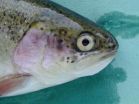(Press-News.org) Paleontologists have unearthed the first extinct penguin with preserved evidence of scales and feathers. The 36-million-year-old fossil from Peru shows the new giant penguin's feathers were reddish brown and grey, distinct from the black tuxedoed look of living penguins.
The new species, Inkayacu paracasensis, or Water King, was nearly five feet tall or about twice the size of an Emperor penguin, the largest living penguin today.
"Before this fossil, we had no evidence about the feathers, colors and flipper shapes of ancient penguins. We had questions and this was our first chance to start answering them," said Julia Clarke, paleontologist at The University of Texas at Austin's Jackson School of Geosciences and lead author of a paper on the discovery in the Sept. 30 online edition of the journal Science.
The fossil shows the flipper and feather shapes that make penguins such powerful swimmers evolved early, while the color patterning of living penguins is likely a much more recent innovation.
Like living penguins and unlike all other birds, Inkayacu's wing feathers were radically modified in shape, densely packed and stacked on top of each other, forming stiff, narrow flippers. Its body feathers had broad shafts that in living penguins aid streamlining the body.
Bird feathers get some of their colors from the size, shape and arrangement of nanoscale structures called melanosomes. Matthew Shawkey and Liliana D'Alba, coauthors at the University of Akron, compared melanosomes recovered from the fossil to their extensive library of those from living birds to reconstruct the colors of the fossil penguin's feathers.
Melanosomes in Inkayacu were similar to those in birds other than living penguins, allowing the researchers to deduce the colors they produced. When the team looked at living penguins, they were surprised to find their colors were created by giant melanosomes, broader than in the fossil and in all other birds surveyed. They were also packed into groups that looked like clusters of grapes.
Why, the researchers wondered, did modern penguins apparently evolve their own special way to make black-brown feathers?
The unique shape, size and arrangement of living penguin melanosomes would alter the feather microstructure on the nano and micro scale, and melanin, contained within melanosomes, is known to give feathers resistance to wear and fracturing. Perhaps, the researchers speculate, these shifts might have had more to do with hydrodynamic demands of an aquatic lifestyle than with coloration. Penguin colors may have shifted for entirely different reasons related to the later origin of primary predators of extant penguins such as seals or other changes in late Cenozoic seas.
"Insights into the color of extinct organisms can reveal clues to their ecology and behavior," said coauthor Jakob Vinther at Yale University, who first noted fossil preservation of melanosomes in bird feathers. "But most of all, I think it is simply just cool to get a look at the color of a remarkable extinct organism, such as a giant fossil penguin."
Inkayacu paracasensis (een-kah-yah-koo par-ah-kah-sin-sis) was discovered by Peruvian student Ali Altamirano in Reserva Nacional de Paracas, Peru. Inkayacu's body length while swimming would have been about 1.5 meters (five feet), making it one of the largest penguins ever to have lived. When the team noticed scaly soft tissue preserved on an exposed foot, they nicknamed it "Pedro" after a sleazy or "escamoso" (scaly) character from a Colombian telenovela.
The latest discoveries add to earlier work by Clarke and her colleagues in Peru that challenges the conventional vision of early penguin evolution. Inkayacu and other finds show there was a rich diversity of giant penguin species in the late Eocene period (about 36 to 41 million years ago) of low-latitude Peru.
"This is an extraordinary site to preserve evidence of structures like scales and feathers," said Clarke. "So there's incredible potential for new discoveries that can change our view of not only penguin evolution, but of other marine vertebrates."
INFORMATION:
The National Geographic Society and the National Science Foundation provided funding for the research.
The paper, "Fossil Evidence for Evolution of the Shape and Color of Penguin Feathers," will appear later in a print edition of the journal. In addition to Clarke, Shawkey, Alba, Vinther and Altamirano, co-authors are Daniel T. Ksepka (North Carolina State University), Rodolfo Salas-Gismondi (Museo de Historia Natural-UNMSM), Thomas J. DeVries (Burke Museum of Natural History and Culture) and Patrice Baby (IRD and Université de Toulouse, France).
Fossilized giant penguin reveals unusual colors, sheds light on bird evolution
2010-10-01
ELSE PRESS RELEASES FROM THIS DATE:
Researchers sequence genome of mosquito that spreads West Nile virus
2010-10-01
RIVERSIDE, Calif. – Last year, 720 people in the United States became infected with West Nile virus, a potentially serious illness that is spread through the bite of a mosquito – the Culex mosquito – that has first fed on infected birds. Such mosquitoes have the virus eventually located in their salivary glands and transmit the disease to humans and animals when they bite to draw blood.
To understand the genetic makeup of the Culex mosquito, and how the insect is able to transmit this and other viruses, an international team of scientists, led by geneticists at the ...
Researchers advance biosynthesis of potent anti-cancer drug Taxol
2010-10-01
MEDFORD/SOMERVILLE, Mass.--Researchers from Tufts University School of Engineering and MIT have reported a new way to biosynthesize important precursors to the potent anti-cancer compound Taxol in an engineered strain of E. coli bacteria.
The findings are significant steps on the way to achieving cost-effective, large-scale production of Taxol and the effort to design new Taxol-like pharmaceuticals.
The work is reported in the October 1, 2010, issue of the journal Science.
Taxol (paclitaxel) and its structural analogs are among the most powerful and commercially ...
Researchers decode genome of mosquito that spreads West Nile virus, encephalitis and elephantiasis
2010-10-01
Chestnut Hill, Mass. (9/30/2010) – Scientists have sequenced the genome of the Southern house mosquito, providing new insights into the most diverse and widespread of three groups of disease-bearing mosquitoes and shedding new light on the transmission of mosquito-borne diseases such as malaria, encephalitis, West Nile virus and filariasis, international teams of researchers report in the upcoming edition of the journal Science.
Breeding in drains, cesspools and other polluted water bodies, Culex quinquefasciatus feeds on blood from birds, livestock and humans and transmits ...
Ethnicity: A reason for heart problems post-transplant in South Asians
2010-10-01
Ethnicity is a contributing risk factor of cardiovascular problems in kidney recipients of South Asian origin post-transplant, according to a study appearing in an upcoming issue of the Clinical Journal of the American Society Nephrology (CJASN).
South Asians comprise 25% of all Canadian visible minorities and have a higher risk for cardiovascular disease in the general population. However, the risk of cardiovascular events has never been studied in this minority population.
To investigate, G.V. Ramesh Prasad, MBBS, MSc, FRCPC, FACP, FASN (University of Toronto) and ...
Fossilized giant penguin feathers reveal color, feather structure of ancient birds
2010-10-01
A North Carolina State University researcher is part of a team that has discovered fossilized feathers from a giant penguin that lived near the Equator more than 36 million years ago. These feathery fossils reveal color patterns in an ancient extinct penguin species, and offer clues to how modern penguin feathers evolved.
The penguin in question – dubbed Inkayacu paracasensis, or Water King – dates from the late Eocene period and stood almost five feet tall. The fossil was discovered near the Paracas Reserve, located along the eastern coastline of Peru. A research team ...
Dinosaurs significantly taller than previously thought, MU researcher finds
2010-10-01
COLUMBIA, Mo.– It might seem obvious that a dinosaur's leg bone connects to the hip bone, but what came between the bones has been less obvious. Now, researchers at the University of Missouri and Ohio University have found that dinosaurs had thick layers of cartilage in their joints, which means they may have been considerably taller than previously thought. The study is being published this week in the journal PLoS ONE (Public Library of Science).
"Our study of the limbs of modern-day relatives of dinosaurs shows that dinosaurs were significantly taller than original ...
Researchers engineer microbes for low-cost production of anti-cancer drug, Taxol
2010-10-01
CAMBRIDGE, Mass. -- MIT researchers and collaborators from Tufts University have now engineered E. coli bacteria to produce large quantities of a critical compound that is a precursor to the cancer drug Taxol, originally isolated from the bark of the Pacific yew tree. The tree's bacteria can produce 1,000 times more of the precursor, known as taxadiene, than any other engineered microbial strain.
The technique, described in the Oct. 1 issue of Science, could bring down the manufacturing costs of Taxol and also help scientists discover potential new drugs for cancer and ...
Major disease-vector mosquito reveals the secrets of its immune system
2010-10-01
1st October 2010 - The Culex quinquefasciatus mosquito poses a significant threat to human health as a blood-sucking transmitter of elephantiasis-causing worms and encephalitis-inducing viruses. An international team of scientists, including researchers from the University of Geneva and the SIB Swiss Institute of Bioinformatics sequenced its genome and studied its responses to pathogen infections. Two articles published in today's issue of Science, describe results from comparing the Culex mosquito with the malaria mosquito, Anopheles gambiae, and the dengue mosquito, Aedes ...
Key nutrient found to prevent cataracts in salmon
2010-10-01
The role of a key nutrient which prevents cataracts in salmon has been revealed by eye specialists at the University of East Anglia.
Research published today in the American Journal of Physiology - Regulatory, Integrative and Comparative Physiology shows how the nutrient histidine, when added to the diet of farmed salmon, stops cataracts (clouding of the lens in the eye) from forming.
Following fears over BSE in the early 1990s, blood meal was removed from the diet of farmed salmon. This coincided with a large increase in the incidence of cataracts which cause economic ...
New study finds groups demonstrate distinctive 'collective intelligence' when facing difficult tasks
2010-10-01
CAMBRIDGE, Mass. -- When it comes to intelligence, the whole can indeed be greater than the sum of its parts. A new study co-authored by MIT, Carnegie Mellon University, and Union College researchers documents the existence of collective intelligence among groups of people who cooperate well, showing that such intelligence extends beyond the cognitive abilities of the groups' individual members, and that the tendency to cooperate effectively is linked to the number of women in a group.
Many social scientists have long contended that the ability of individuals to fare ...


